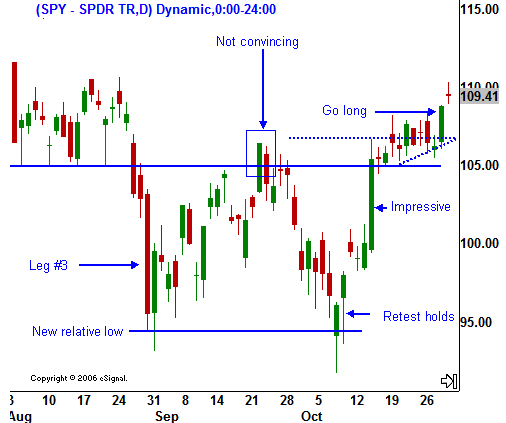Two years ago I wrote a series of articles on how to trade “V” bottoms. WE ARE NOT IN A “V” BOTTOM SET-UP – WE ARE IN A BEAR MARKET. This stage of the trading strategy does tell you how to trade once the low has been established. We are near a capitulation low and these instructions should help you trade bear market rallies. To read all of the articles, please use the Search box and enter “V” Bottoms as the keyword.
In Leg 3, we saw the market break below SPY 105 and make a new relative low at 95. From a bearish perspective, we want to see the market struggle when it bounces off of 95 support. Ideally, it will make a series of lower highs within that range. In this case we can see that the market snapped back and it ran right up to 105. In fact, it briefly broke through.
.
.
.
.
We should lighten our short positions on that type of bounce, but it’s premature to bail out on all of the short positions. The market will hit oversold conditions and the snap back rallies can be violent. We need to make sure that the price movement is bona fide before we exit all bearish positions.
It is also too early to start getting long, we need to see follow through to justify turning bullish. This was the first warning shot for the bears. We need to step up our efforts to find stocks that we want to own. Seek out stocks that were particularly strong before the entire sell off started. They are the stocks that have held up well and are leading the market higher on the snap back rallies.
As it turns out, the market failed to break out on its first attempt and it gave us a chance to execute Leg 4 of our strategy. Here are some of the key points to keep in mind.
1. Look for support as the market tests the recent low (SPY 95). If the market finds support before that low is tested and it rallies, exit remaining short positions. This price action shows you that the bulls are getting more aggressive. They can’t even wait for the support to be tested – they want to buy stocks now.
2. If the market is able to test the support level, hold remaining short positions in case there is another leg down. If the market bounces off of that support and it rallies sharply, exit remaining short positions. The support has been tested and it held.
3. In this example we can see that the market bounced and it is time to execute another strategy. This is a great time to sell naked puts on stocks that you want to own. The option implied volatilities are still very high and you will be properly rewarded for the risk you are taking. If you stay with out of the money options you can distance yourself from the day to day volatility and you are less likely to get whipsawed out of a position.
4. If the market rallies through the resistance level that marked the beginning of this leg (SPY 105) then you need to shift from a bearish bias to a bullish bias. Remember, this is a “V” bottom. The market is in a long-term uptrend and this is a sharp, temporary decline. We want to take advantage of a good entry point for long positions.
5. This is where many traders go wrong. When you get long, you need to place buy stops above resistance levels for each stock and buy shares of companies you want to own. When the market springs higher, all of your orders will be waiting for the breakout. These rallies come quickly and you can’t react fast enough. They can come in the form of a sharp intraday reversal or they can result from an event. The bulls aggressively buy-in and the shorts scramble to try and cover.
The option bid/asks widen dramatically and you will continually be trying to lift offers. Option exchanges often declare “floor-wide fast markets” in these situations and you might not get filled. The auto quote systems are trying to keep up and they can’t adjust all of the various option prices fast enough. Remember, the option premiums are very elevated because the market has just come off of a deep trough. When the market rallies the implied volatilities drop and long call positions are “swimming upstream”. Even though the price of the stock is going up, you’ll find that the wide bid/ask spread and the drop in implied volatility is stealing a huge part of your profit.
The stock shares are very liquid and you’ll be able to get in and out with a minimum amount of slippage. The stock exchanges and ECNs are better equipped to handle these large volume surges. You should plan on holding the stock positions for at least two to three days. Your holding period will be dependent on the magnitude and momentum of the move. A big explosive move that stalls would prompt you to take profits quickly. An extended, grinding move up would permit you to stay with the stock positions for a longer period.
In the example I’ve used, you can see that the market was able to test the SPY 95 support level and it quickly rallied back up to the 105 level. As it did so the second time, you would be exiting your remaining short positions and you would be establishing naked put writes. This time around the market was able to penetrate the 105 level and it started to grind higher. You have enough confirmation that the market is going to rebound and this is when you start placing your stock buy-stop orders. If the market fails, your buy stops will not be triggered and you can reevaluate. If the market takes off, you’ll be ready.
The trading during these periods can be fast and furious. If you don’t have a well-defined game plan and if you don’t know your exit points for each position, you will be running around with your head cut off. In my next blog I’ll discuss the strategy for the final phase of the “V” bottom.










